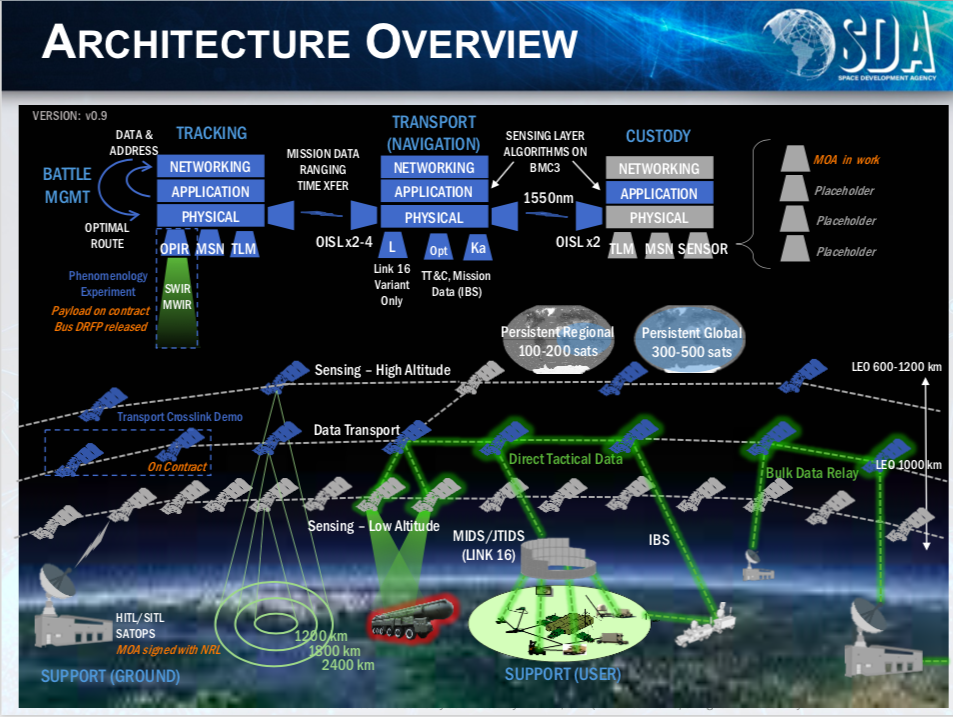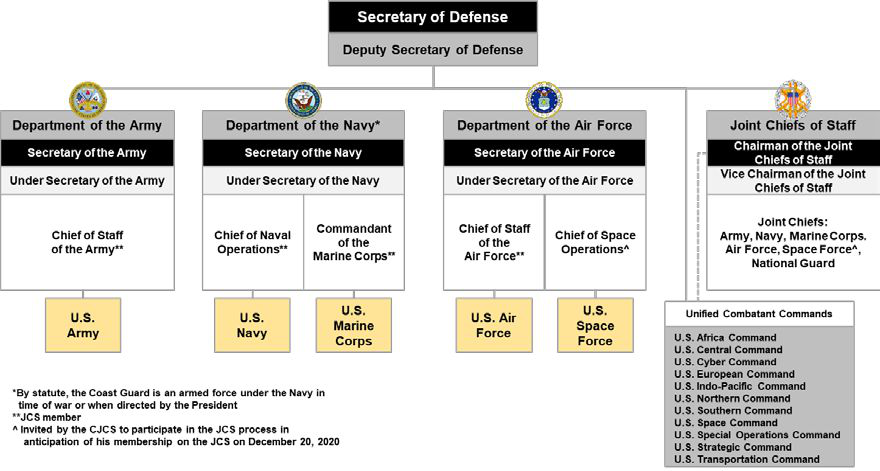As the space domain has become more congested, the potential for intentional and unintentional threats to space system assets has increased. Space is also becoming another domain of conflict due to enhanced militarization and weaponization of space. This is driving nations whose military is highly dependent on space to launch their military space strategy to protect their space based assets.
China and Russia have made significant investments in space-based technologies, from anti-satellite weapons to advanced surveillance systems. These advancements pose a direct challenge to the United States’ space superiority and underscores the need for robust space strategies to safeguard critical assets and ensure strategic superiority in space.
Updated National Space Strategy
The United States National Space Strategy, introduced in March 2018, presents a forward-looking and comprehensive blueprint to safeguard American interests and maintain strategic leadership in the increasingly contested space domain. The strategy is built on four interdependent pillars that collectively address the challenges and opportunities in space operations.
1. Resilient Space Architectures
The strategy emphasizes the transition to survivable and redundant space systems, ensuring operational continuity even in hostile environments. This includes the adoption of distributed constellations in low Earth orbit (LEO) to mitigate the risks associated with single points of failure, the development of hardened satellite designs resistant to electronic warfare and physical attacks, and the incorporation of artificial intelligence (AI) for autonomous anomaly detection and recovery. These advancements enable the U.S. to maintain critical functions such as communication, navigation, and surveillance in contested scenarios.
2. Strengthening Deterrence and Warfighting Options
To deter and respond to space-related aggression, the strategy calls for robust capabilities that signal strength and readiness. This includes advancements in counterspace technologies, such as directed energy systems, jamming capabilities, and kinetic options to neutralize hostile threats. The integration of space-based missile defense systems and enhanced space domain awareness (SDA) platforms ensures rapid identification and assessment of adversarial actions. By coupling these capabilities with a clear policy of deliberate response, the U.S. reinforces the credibility of its deterrence posture.
3. Foundational Capabilities and Processes
Effective space operations rely on a strong foundation of situational awareness, intelligence gathering, and efficient acquisition processes. The strategy prioritizes investments in advanced SDA systems capable of tracking and identifying objects in orbit with unprecedented accuracy. The integration of machine learning algorithms further enhances threat prediction and operational planning. Streamlined acquisition frameworks, such as accelerated prototyping and iterative testing, allow for the rapid deployment of cutting-edge technologies, reducing time-to-market for critical capabilities.
4. Fostering Commercial and International Collaboration
Recognizing the value of partnerships, the strategy advocates for streamlined regulatory frameworks to foster private sector innovation and promote international cooperation. By collaborating with allies and commercial entities, the U.S. enhances its ability to share burdens, pool resources, and collectively address shared threats. Initiatives such as public-private partnerships (PPPs) and bilateral agreements with allied nations support exploration, sustainable space development, and the mitigation of common security risks. The strategy also underscores the need for norms of responsible behavior to ensure a safe and stable space environment.
Strategic Vision and Policy Commitments
The updated strategy unequivocally states that any attack on U.S. space assets will prompt a calculated and deliberate response at a time and place of the nation’s choosing, reaffirming America’s commitment to protecting its interests. It also emphasizes leveraging the ingenuity of the private sector to drive innovation and maintain technological superiority. By fostering global partnerships and aligning efforts across government, industry, and allies, the strategy ensures a holistic approach to addressing the challenges of a dynamic and contested space domain.
Through these pillars, the National Space Strategy positions the United States to navigate emerging threats, seize new opportunities, and maintain its leadership in space for years to come.
Space Force: Operationalizing the Strategy
Space Development Agency (SDA): Driving Innovation
The Space Development Agency (SDA), established in March 2019, plays a pivotal role as the U.S. Department of Defense’s (DoD) innovation hub for space technologies. Often likened to a mini-DARPA, the SDA is focused on integrating cutting-edge technologies into military space programs to create a resilient and adaptive space architecture. The agency’s efforts are central to advancing the U.S. military’s capabilities in space, ensuring robust, responsive, and secure operations in an increasingly contested domain.
Core Capabilities of the SDA
The SDA is driving forward several core capabilities that will significantly enhance U.S. space capabilities:
- Persistent Global Surveillance for Advanced Missile Targeting
The SDA is developing systems for continuous, high-resolution surveillance to support advanced missile targeting. This involves deploying space-based sensors capable of detecting and tracking missiles, ensuring timely and effective response to potential threats. - Space Situational Awareness for Near-Real-Time Threat Detection
A critical function of the SDA is to enhance space situational awareness (SSA), which involves the use of space-based sensors to monitor and detect threats in near-real-time. This is essential for avoiding collisions, tracking hostile actions, and protecting U.S. space assets from emerging adversarial threats. - Development of Deterrence Capabilities
As part of its mission, the SDA works to integrate space deterrence capabilities into the broader U.S. defense strategy. This involves developing technologies that can deter adversaries from engaging in hostile actions in space, ensuring U.S. superiority in space warfare. - Alternate Navigation and Timing Systems for GPS-Denied Environments
The SDA is investing in alternative navigation and timing systems that can function in environments where traditional GPS signals may be jammed or denied. This is crucial for maintaining operational continuity in contested or hostile space environments. - Secure and Resilient Communication Infrastructure
The SDA is advancing efforts to build secure and resilient communication systems that can withstand cyber-attacks and other disruptions. This includes developing next-generation communication networks capable of supporting military operations across the globe. - AI-Enabled Global Surveillance and Target Recognition
The SDA is incorporating artificial intelligence (AI) into its surveillance systems, enabling real-time data processing and target recognition. AI-driven systems enhance decision-making processes, enabling faster, more accurate responses to potential threats.
Flagship Initiative: Multi-Layered Constellation of Small Satellites
At the heart of the SDA’s strategy is the development of a multi-layered constellation of small satellites in Low Earth Orbit (LEO). This constellation will provide a versatile, scalable, and resilient space infrastructure that is essential for meeting the operational demands of the U.S. military.
The core of the Pentagon’s ambitious space strategy is the Tracking Layer, a network of satellites positioned in low Earth orbit (LEO) that serves as the backbone for communication and data flow between satellites and the ground. The Tracking Layer will play a crucial role in ensuring that data from satellites in orbit can be efficiently transmitted to the ground, and vice versa. Alongside it, the Transport Layer will be essential for linking on-orbit sensors to weapons systems, facilitating the seamless flow of information for quick decision-making and operational response on the ground or in the air.
- Transport Layer: The transport layer serves as a data relay network that enables seamless communication between satellites and ground systems. This network will ensure that military space operations remain connected and operational even in the event of disruption or communication denial.
- Tracking Layer: The tracking layer provides advanced missile warning and tracking capabilities, helping to detect and track ballistic missiles and other threats in real-time. This layer is crucial for ensuring rapid response to missile threats and protecting critical assets.

The Space Development Agency (SDA) has made impressive strides in building its space architecture, marking several key milestones and outlining ambitious plans for future expansion. The initial phase, known as Tranche 0, saw the acquisition of 28 satellites in 2020, which were successfully launched in 2022. This constellation served as a critical foundation for the SDA’s long-term vision of a robust and interconnected satellite network. With the deployment of Tranche 0, the SDA demonstrated its ability to establish a scalable, resilient space-based infrastructure capable of supporting a variety of mission sets, from communications to missile defense.
Looking ahead, the SDA is set to expand its constellation with the deployment of Tranche 1 in 2024, which will include 100 to 150 satellites from multiple vendors. This next phase will emphasize the use of open architectures, fostering interoperability and enhancing system flexibility across different platforms. Additionally, the SDA is focused on incorporating commoditized technologies, which are expected to significantly reduce costs while simultaneously improving satellite performance. To accelerate progress, the SDA has also called for the development of cutting-edge technologies, such as miniaturized optical inter-satellite links for faster data transmission, NSA-approved encryption for secure communications, and AI-enabled remote sensing capabilities for enhanced surveillance and target recognition. These advancements are designed to ensure the SDA’s space architecture remains at the forefront of technological innovation and operational effectiveness in the years to come.
Integration with the Space Force
In 2022, the SDA was integrated into the Space Force, consolidating space-related innovation efforts under a single, unified command. This integration has enhanced strategic coherence, aligning the SDA’s innovation initiatives with the Space Force’s broader mission to secure U.S. space assets and maintain space superiority.
By creating a resilient, adaptable space infrastructure, the Space Development Agency is playing a crucial role in ensuring that the U.S. military remains at the forefront of space innovation. Through its work in satellite constellations, space-based surveillance, and cutting-edge technologies, the SDA is laying the groundwork for a more secure, efficient, and capable U.S. military in space.
National Defense Space Architecture (NDSA)
The National Defense Space Architecture (NDSA), developed by the Space Development Agency (SDA), is a transformative framework designed to strengthen U.S. national security in space. Its primary goal is to enhance the detection, tracking, and targeting of time-sensitive ground and maritime threats, particularly focusing on advanced missile defense, including hypersonic and ballistic missile systems. By leveraging space-based assets, the NDSA aims to provide a resilient, persistent, and global defense network capable of addressing emerging threats in the space domain.
Addressing Emerging Hypersonic Threats
Hypersonic weapons represent one of the most significant challenges to current missile defense systems. These weapons are maneuverable at extremely high speeds, often traveling at 5 times the speed of sound or more, and can evade traditional detection methods. In space, they are much harder to track due to their relatively dim thermal signature compared to ballistic missiles, appearing 10-20 times dimmer from geosynchronous orbit. To combat this challenge, the NDSA adopts a proliferated Low Earth Orbit (LEO) architecture, positioning a constellation of satellites closer to Earth, typically below 1,200 miles. This closer proximity significantly enhances the effectiveness of infrared sensors, enabling the tracking of hypersonic weapons during their flight, even through complex maneuvers.

Core Components of the NDSA
The NDSA is structured into seven interconnected layers, each designed to play a critical role in creating a comprehensive, resilient space-based defense system:
- Tracking Layer:
- This layer uses wide-field-of-view (WFOV) sensors to detect and track hypersonic and ballistic missile threats.
- It integrates with the Hypersonic and Ballistic Tracking Space Sensor (HBTSS), a medium-field-of-view (MFOV) system developed by the Missile Defense Agency (MDA), which provides precise targeting data for missile interception.
- Transport Layer:
- A mesh network consisting of 300-500 optically interconnected satellites, this layer provides low-latency data communication between satellites and ground systems.
- It plays a critical role in linking sensors with command-and-control systems, supporting Joint All-Domain Command and Control (JADC2) to ensure coordinated operations across all domains.
- Custody Layer:
- This layer focuses on persistent Intelligence, Surveillance, and Reconnaissance (ISR) capabilities, tracking mobile ground and maritime targets in real-time.
- Deterrence Layer:
- The Deterrence Layer is focused on space domain awareness, including monitoring activities in the cislunar region (the area between Earth and the Moon), which is critical for future space operations.
- Battle Management Layer:
- This layer enables space-based command and control, coordinating military operations across all layers of the NDSA to ensure synchronized and effective defense strategies.
- Navigation Layer:
- The Navigation Layer provides alternative Positioning, Navigation, and Timing (PNT) solutions in GPS-denied environments, ensuring continued operational effectiveness in contested or denied environments.
- Support Layer:
- The Support Layer facilitates the operational, maintenance, and management functions needed to ensure the resilience and continuous operation of the other layers within the NDSA.
Tranche Development and Deployment
The SDA employs an iterative, phased approach for the development and deployment of the NDSA, structured around several “tranches” (phases) to gradually expand capabilities:
- Tranche 0 (Demonstration Phase): The initial phase focused on prototypes and experimental projects, such as Mandrake II and LINCS, to demonstrate the viability of key technologies and capabilities.
- Tranche 1 (Operational Phase): This phase will deploy 100-150 satellites, expanding the system’s operational coverage for regional persistence and global coverage. It includes advanced WFOV and MFOV satellites to ensure continued progress in missile tracking and defense.
The ultimate goal of the NDSA is to achieve full operational capability with a constellation of 550 satellites by 2025, providing global coverage for missile detection and tracking, enhancing the U.S. military’s ability to respond to advanced threats with greater precision and resilience.
Leveraging Commercial and Defense Collaborations
Conclusion
The space domain’s increasing congestion and contention necessitate a proactive and comprehensive approach. The United States has demonstrated its commitment through its National Space Strategy, the establishment of the Space Force, and the integration of the SDA into its strategic framework. By fostering innovation and collaboration, the U.S. is positioning itself to secure its interests, deter adversaries, and lead the next frontier of space exploration and security.
Reference and Resources also include:
 International Defense Security & Technology Your trusted Source for News, Research and Analysis
International Defense Security & Technology Your trusted Source for News, Research and Analysis




